- AccurateRip
- Acoustid
- AES/EBU
- AirPlay
- Amplifier
- aptX
- Audio file formats
- ASRC
- AVB
- Bit perfect jitter
- Bits: 16 or 24
- Bit perfect playback
- Bitrate
- Bluetooth
- Burn-in
- BWF
- Cables
- CDtext
- Chromecast
- Clipping
- Clock
- Codec
- Compression
- CRC
- Crossover
- Cue sheet
- DAC
- Damping
- DASH
- Digital
- Digital Room Correction
- Dither
- DLNA
- Drivers
- DoP
- DSP
- EBU R128 (loudness)
- FFT
- FireWire
- Freedb
- Gapless playback
- Generation loss
- HDMI
- Headphone listening
- Hearing
- Hires recording
- Homeplug
- I2S
- ID3
- Inter sample peak
- LDAC
- Linearity (DAC)
- Memory playback
- Music Server
- OCF
- OFC
- PCM
- Perception
- RAID
- ReplayGain
- Ripping
- RFI
- RIAA
- Router
- Sampling, up and over
- Sample Rate Conversion
- Speakers
- S/PDIF
- Storage
- Sync
- Tagging
- Toslink
- Transcoding
- UAA
- Units
- UPnP
- USB
- VST
- WiFi
- WiSA
WAV
WAV or WAVE (Waveform Audio File Format): Audio file format for Windows developed by Microsoft and IBM. WAV support was built into Windows 95 and has become an industry standard since. A variety of applications now support WAV files, as do additional operating system platforms, such as Macintosh. WAV indicates “sound file”, not a specific format of the file. WAV files can be 1-24 channels, 8-32 bit, fixed-point or floating point, compressed or uncompressed, etc. The WAV specification includes an “others” area, called the INFO CHUNK, which can be stored any additional data (e.g. a database, text, video, pictures, etc.). The INFO CHUNK, in the file “header”, is most commonly used to store metadata. While widely adopted, there is no standard format for this information.
Source: BCR
WAV appeals to the audiophile mind, probably because if you rip a CD to WAV the result is as close as you can get to the CD-format (uncompressed 16 bits/ 44.1 kHz PCM audio).
Indeed WAV, AIFF and audio CD's contain LPCM (Linear PCM). However you can't burn WAV (or AIFF) straight to a data CD. If you want it to play, you must create a true audio CD that adheres to the Redbook standard as the audio CD format is incompatible with WAV (or any other computer audio format).
There is an exception to this rule. There are CD players that can play MP3 from a data CD. Most of all used in car audio.
You can store anything in WAV, including video or lossy compressed audio. However, when a media player opens a WAV if will look for a RIF chunk aptly labeled "WAVE". Almost all of the time, this contains WAVE_FORMAT_PCM. If not, your media player probably chokes. So regardless of the content of this container, you get LPCM.
As the file size is part of the header and they use a 32 bit integer, file size is limited to 4 GB.
Sample rate ranges from 1 Hz to a whopping 4.3 GHz.
The number of channels can be as high as 65535.
Tagging
In your audiophile fervor, you rip all your CDs to WAV.
One day you tried another player or you move the files to a new computer and find out that album title, song title, art work, all the Meta data you provided are gone.
All those hours you spend meticulously adding the right information are wasted.
This is the paradox of WAV, the support for the music part is almost universal, the support of tagging haphazard.
Due to all these technical problems a lot of people believe that it is impossible to tag WAV.
This is simply not true
The RIFF header allows for tags like:
IART (artist)
INAM (title)
IPRD (product)
IGNR (genre)
ITRK (track number)
This is not suffcient, we are missing ALBUM
This can besolved by writing tags in a info chunk.
LIST....INFO Meta data
INAM Track title.
IPRD The album title.
IART The artist who created this.
ICRD The creation date in YYYY-MM-DD format, however you should expect to see just YYYY in this field.
ITRK Track number.
ICMT A text comment.
IKEY The keywords for the project or file.
ISFT The software used to create the file.
IENG The engineer.
ITCH The technician.
IGNR Genre of content.
ICOP The copyright information.
ISBJ The subject.
IENG The name(s) of the engineer. Multiple names separated by a semicolon and a blank.
ISRC Source: the name of the person or organization that supplied the original subject of the file.
LIST....adtl Markers
labl An entry in an array containing an a label or name which is associated with the cue points from the "cue " tag in order to provide names for the markers. It seems to sit in its own LIST/INFO section separate from the meta data.
No provision for cover art. Tags like Composer, Orchestra, Soloist, Encoder, etc. are also missing. Obvious WAV can be tagged. Compared with the ID3 standard the tag set it is a bit limited.
If you decide to go for WAV you can use the following strategies:
- Don't tag, use a well-defined file structure to browse your collection.
You need meaningful file names.
1_Franz Schubert _Schubert: Lieder, Vol. 2 (Box Set)_D. 699_Der entsühnte Orest ("Zu meinen Füssen brichst du dich"), song for voice & piano _1820_Dietrich Fischer-Dieskau / Gerald Moore
Beware of the 256 byte limit for the length of path/filename.
Beware of special characters, if you transfer from Win to Linux (NAS) some special characters gives problems.
-
Moving library and audio.
As most media players allows you to enter all kind of information but stores this in the library (database) only and not in the WAV, a possible but risky scenario is to move both library and the audio files to another PC.
Both library and audio has to be in the same location on the new machine.
-
Media players supporting tagging WAV using ID3 style.
JRiver Media Center, dBpoweramp, Foobar can read/write tags in WAV.
They write ID3 style tags (see below).
A good solution but you are restricted to these products. The moment you move to another media player you can't read this tags anymore.
- Don't tag but use a cue sheet
This requires a media player handling cue sheets. Probably the most elegant solution when using WAV. Be careful when handling audio files. If you rename them, the name has to be changed in the CUE as well. Likewise, if you move the WAV, you have to move the CUE as well. Media players often has the option to generate folder structure and file name from tags. This will go wrong when they don't handle the CUE properly.
-
Use BWF
This is sometimes recommended on audio forums.
The Broadcast Wave Standard is an extension of the original WAV standard but most of the additional tags as defined by this standard are of little relevance within the context of a media player (assuming it supports BWF)
- Don't use WAV but use a lossless format which supports tagging.
If in doubt if this would compromise sound quality, do a unsighted listening test between WAV and its lossless alternative.
Don't forget, lossless is lossless, given the right software you don't tie your hands, you can always convert to another lossless format without compromising sound quality.
If you pretend to hear a difference between WAV and FLAC, try memory playback.
Memory playback removes all the differences due to processing.
From 14.1 on, dBpoweramp supports uncompressed FLAC
Source : dBpoweramp
This sounds like we finally have WAV with excellent tagging options.
Your best bet is converting to FLAC (unless on a MAC). Today lossless compression is not that relevant anymore as prices of storage has dropped substantially. Having your audio lossless and excellent tagging support at the same time is a great asset.
Open WAV
A couple of developers use the same convention to write IDV3 tags in WAV.
This convention is supported by
- dBpoweramp
- Foobar
- JRiver Media Center
- MusiCHI
- MusicBee (partial)
- Bliss
There might be others but these are the ones known to me.
This is a track ripped to WAV by dBpoweramp
 At the bottom of the file you will find ID3 tags.
At the bottom of the file you will find ID3 tags.
Most of the time the tags are written in the header of a file.
If there isn't enough space the entire file must be rewritten.
If an error is made this might invalidate the entire audio part too.
Writing the tags at the end of the file solves these problems.
Excellent solution.
dBpoweramp
In Win Explorer you can view and edit them using the dBpoweramp plug-in.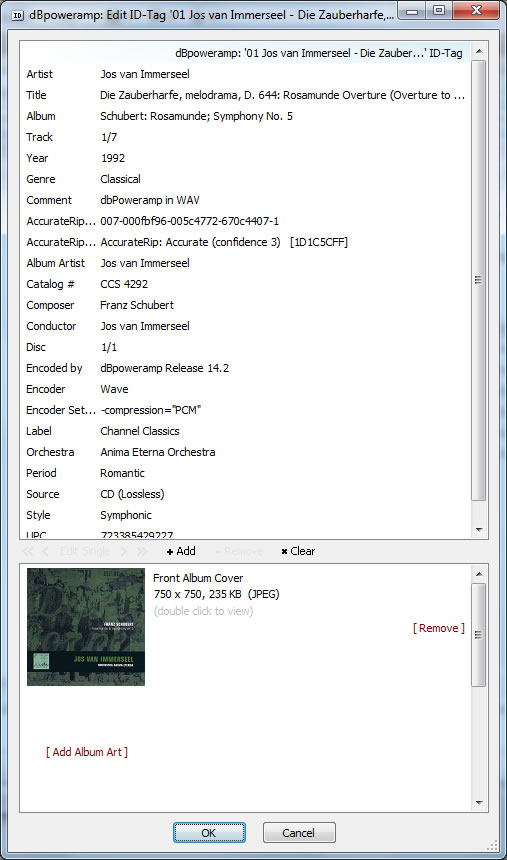
Bliss
From November 2015 on, Bliss supports this convention as well.
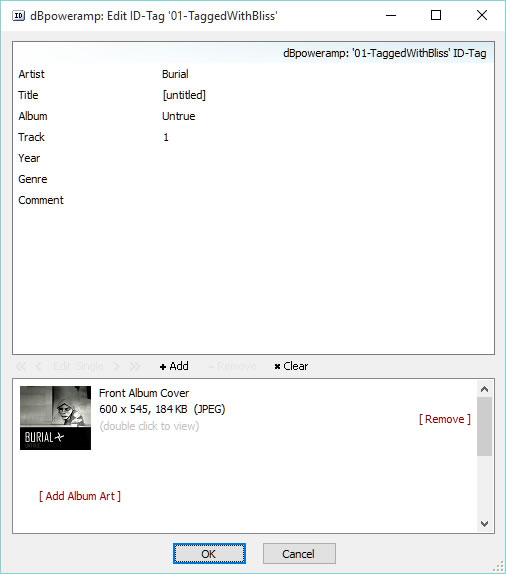
Foobar
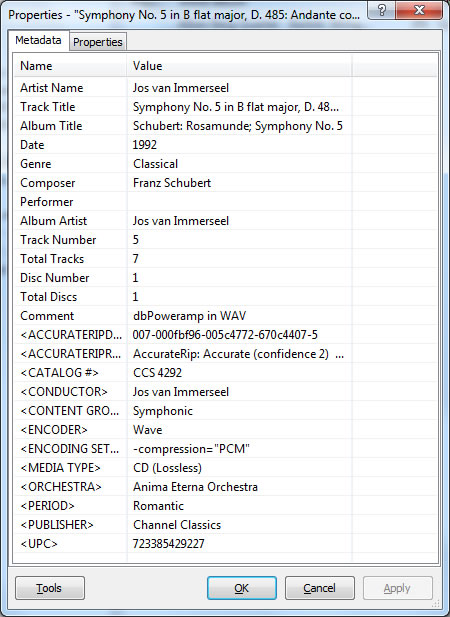
Foobar reads them without a flaw.
JRiver
Uncompressed Audio File (wav)
44.1 kHz, 16 bit, 2 ch
ID3v2.3 Tag: (243712 bytes)
TXXX (AccurateRipResult): AccurateRip: Accurate (confidence 3) [91E21E50]
TXXX (AccurateRipDiscID): 007-000fbf96-005c4772-670c4407-2
TIT2 (Name): Rosamunde, Fürstin von Cypern, incidental music, D. 797 (Op. 26): Entr'acte in B major (Andantino)
TPOS (Disc #): 1/1
TYER (Year): 1992
TCOM (Composer): Franz Schubert
TPE3 (Conductor): Jos van Immerseel
TPUB (Publisher): Channel Classics
TXXX (UPC): 723385429227
APIC (Image File) (Cover): <too large to display>
TALB (Album): Schubert: Rosamunde; Symphony No. 5
TCON (Genre): Classical
TPE1 (Artist): Jos van Immerseel
TPE2 (Album Artist): Jos van Immerseel
TXXX (Orchestra): Anima Eterna Orchestra
TXXX (Catalog #): CCS 4292
TIT1 (Grouping): Symphonic
TXXX (Period): Romantic
COMM (Comment): dBpoweramp in WAV
TRCK (Track #): 2/7
TMED: CD (Lossless)
TENC: dBpoweramp Release 14.2
TXXX (Encoder): Wave
TSSE (Encoding Settings): -compression="PCM"
MusiCHI
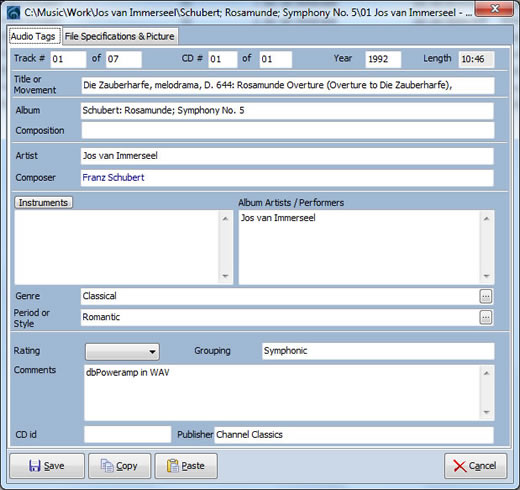
MusicBee


MusicBee support not all of them.
I miss the composer tag most of all
Windows Media Player 12
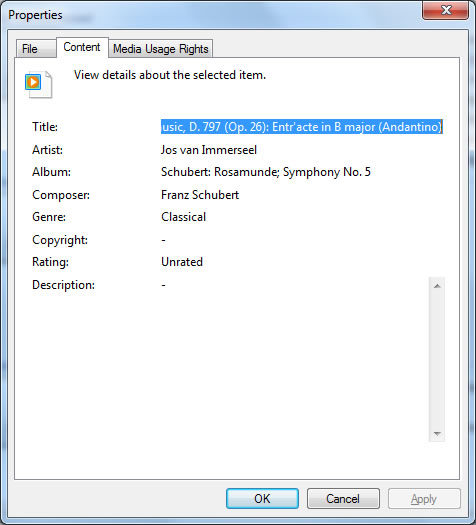
Poor support.
Multimedia Programming Interface and Data Specifications 1.0 - IBM Corporation and Microsoft Corporation - 1991
WAV - Wikipedia

